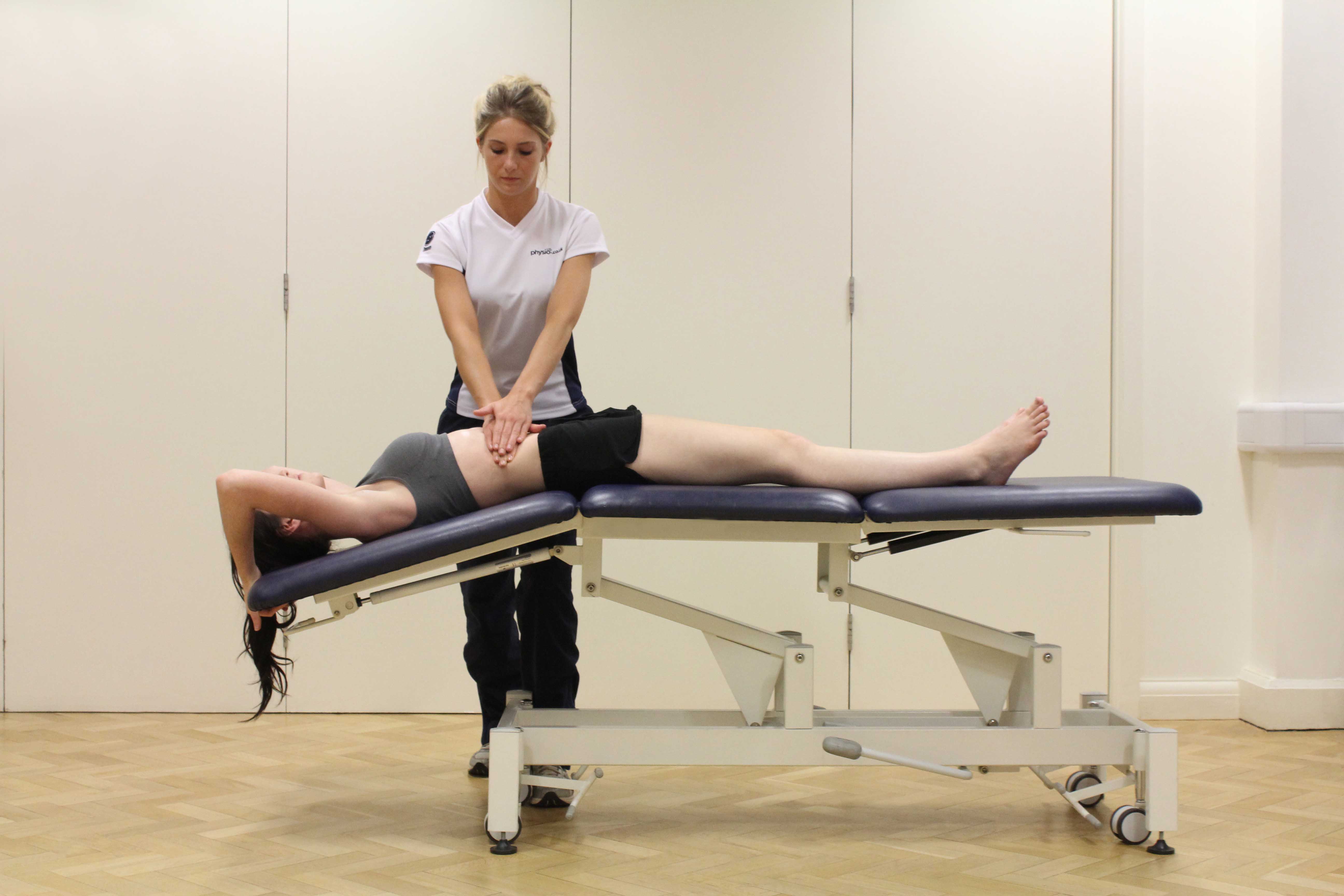- Personal preference
- An oversized baby in comparison to the pelvic area
- Incorrect positioning of the baby whilst in the uterus (breech position)
- If you have already had a caesarean section
- Premature labour
- An extremely high blood pressure related to the pregnancy (pre-eclampsia)
- Your baby is not receiving adequate oxygen during the labour
- If you are expecting twins, triplets or more
- The placenta is obstructing the exit to the uterus (placenta praevia)
- Some infections which may pass on to the baby (HIV, genital herpes)
- If the labour is not continuing at a normal rate and the baby is not moving
- Other medical conditions such as diabetes, hypertension (high blood pressure) and obesity although they do not mean that a natural birth is not an option
- Women over the age of 35
 Above: Soft tissue massage of the abdominal muscles by experienced MSK therapist
Above: Soft tissue massage of the abdominal muscles by experienced MSK therapistThere are different types of caesarean sections depending on your reasons for the operation:
Planned: the reasons for the operation are identified during the pregnancy
Emergency: the baby needs to be delivered immediately which is shown during labour
Elective: the operation is planned by you due to personal preference rather than a medical requirement
The recovery from a caesarean section is much longer than a normal vaginal delivery and physiotherapy can be a very effective way of preparing your body before the operation if it is planned. The specialist physiotherapists at Physio.co.uk can design an individualised programme to help with your recovery after the operation regardless of which type. Physiotherapy is also important following a caesarean section because is minimises the risk of low back pain by improving posture and the support to the lower back. This then prepares the body for any pregnancies in the future.
 Above: Soft tissue massage of the abdominal muscles by experienced MSK therapist
Above: Soft tissue massage of the abdominal muscles by experienced MSK therapistPhysiotherapy prior to a hysterectomy
Your physiotherapist at Physio.co.uk will provide you with a gentle programme before your operation if it is planned. This may include:
- Pelvic floor strengthening exercises
- Preparation and advice about the operation and what to expect
- Transverse abdominis (the deepest layer of stomach muscle) muscle strengthening exercises
- Cardiovascular activity including swimming, walking and gentle cycling
- Upper limb activity
- Range of movement exercises
- Coping techniques for when you are in labour including relaxation, comfortable positioning and deep breathing exercises
Symptoms following a Caesarean
You will experience various temporary symptoms following the operation which your physiotherapist at Physio.co.uk will discuss with you before the surgery about how best to prepare for them. These may include:
- Bleeding from the operation
- Stitches and a scar from the abdominal incision
- Swelling and bruising around the wound
- Temporary pain from the operation
- Temporary loss of sensation around the wound where the nerves have been damaged during the operation
Physiotherapy following a Caesarean section
During the first few days, you are likely to feel very tired and unable to do your normal activities of daily living. The physiotherapy programme at Physio.co.uk will include:
Week 1
- Advice about pacing your day to balance rest and activity
- Advice about comfortable positioning
- Advice about certain movements such as turning, standing, sitting and getting in and out of bed or a chair
- Feeding and sitting postures
- Back care advice
- Deep breathing and circulation exercises to keep your chest clear
- Postural advice
- Continue transverse abdominis exercises
- Continue pelvic floor strengthening exercises
- Electrotherapy techniques such as Megapulse or Ultrasound to reduce the haematoma of the wound (bleeding)
- Foot and ankle exercises to reduce the risk of deep vein thrombosis (DVT)
Weeks 2-5
You should feel less pain from the operation and able to do slightly more activities of daily living than before. Care should still be taken when lifting and handling heavy items and pacing your day. Your physiotherapy programme from Physio.co.uk will now concentrate on:
- Progressing the pelvic floor and abdominal strengthening exercises
- Increasing cardiovascular levels. This can be done by gradually increasing the amount of brisk walking that you do each day and your normal activities
- Upper limb range of movement and strengthening exercises
Week 6 onwards
You should now be experiencing few symptoms and close to a full recovery from your operation. Your physiotherapy programme at Physio.co.uk will concentrate on more functional exercises and maintaining good posture and comfortable positioning. It is important that you continue with your pelvic floor and abdominal exercises long term to provide support for your lower back and prepare you if future pregnancies are an option. Your physiotherapist can also advice you on useful and safe exercises to carry out if you are pregnant again in the future.
Summary
A caesarean section is an operation which delivers a baby through an incision in the front abdominal wall which can be done for a variety of reasons. In comparison to a normal vaginal labour, the recovery is much longer due to the invasive nature of the operation. Physiotherapy is an important part of the recovery process and is useful to have before and following your operation. The experienced physiotherapists at Physio.co.uk will work with you to design a personalised programme to ensure that your recovery is as successful and pain-free as possible. To book a physiotherapy appointment, call Physio.co.uk on 0330 088 7800 today!

 0330 088 7800
0330 088 7800


































